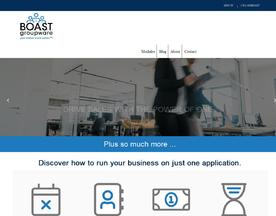What is fanatical prospecting? Fanatical Prospecting is an aggressive sales strategy focusing on consistent, proactive outreach to generate leads, build pipelines, and drive sales success.
Fanatical prospecting is a sales technique that involves pursuing leads with relentless determination and unwavering focus. It is a mindset that requires salespeople to be proactive in their approach, constantly seeking out new opportunities and building strong relationships with potential customers. Jeb Blount, a renowned sales expert and author, is a strong advocate of fanatical prospecting and has written extensively on the subject.

At its core, fanatical prospecting is about building a strong sales pipeline. This means identifying potential customers, engaging with them in a meaningful way, and ultimately converting them into paying clients. While many salespeople focus solely on closing deals, fanatical prospecting emphasizes the importance of building long-term relationships with customers, which can lead to repeat business and referrals.
To be successful at fanatical prospecting, salespeople need to master a variety of techniques and channels. This includes everything from cold calling and email outreach to social media marketing and networking events. Overcoming obstacles in sales, such as rejection and burnout, is also a key component of the fanatical prospecting mindset. With the right skills, knowledge, and motivation, salespeople can become true masters of their craft and achieve unparalleled success in their careers.
Key Takeaways
- Fanatical prospecting is a sales technique that involves pursuing leads with relentless determination and unwavering focus.
- Building a strong sales pipeline is essential for success in fanatical prospecting.
- Salespeople need to master a variety of techniques and channels to be successful, and must also overcome obstacles such as rejection and burnout.
The Fundamentals of Fanatical Prospecting

Understanding Fanatical Prospecting
Fanatical prospecting, as coined by sales expert Jeb Blount, is the process of continuously and aggressively seeking out new sales prospects. It involves identifying potential customers, reaching out to them, and nurturing relationships with them until they are ready to make a purchase. Fanatical prospecting is a crucial component of sales success, as it ensures a steady stream of leads and opportunities.
The Role of Persistence in Prospecting
Persistence is key to successful fanatical prospecting. Sales professionals must be willing to make multiple attempts to reach potential customers, and they must be able to handle rejection without becoming discouraged. Mental toughness is a critical aspect of persistence, as it allows sales professionals to maintain focus and motivation even in the face of adversity.
Developing a Prospecting Mindset
To succeed at fanatical prospecting, sales professionals must develop a prospecting mindset. This involves understanding the importance of prospecting and making it a priority in their daily activities. It also requires a willingness to learn and adapt, as well as a commitment to continuous improvement.
One effective way to develop a prospecting mindset is to establish a prospecting routine. This can include setting aside a specific time each day for prospecting activities, such as making phone calls or sending emails. It can also involve using tools and resources, such as sales automation software, to streamline the prospecting process.
Overall, fanatical prospecting is a critical component of sales success. By understanding the fundamentals of fanatical prospecting, including persistence and developing a prospecting mindset, sales professionals can build a steady stream of leads and opportunities that will help them achieve their sales goals.
Here is an external resource with more information on fanatical prospecting by Jeb Blount.
Building a Strong Sales Pipeline

The Importance of a Healthy Pipeline
A healthy sales pipeline is essential for any business looking to achieve long-term success. Without a steady flow of qualified leads, sales reps can find themselves in a sales slump, struggling to hit their targets and generate revenue. A strong sales pipeline not only helps to avoid an empty pipeline but also ensures that the sales team has a consistent source of potential customers to engage with.
Strategies for Filling the Sales Pipeline
There are several strategies that businesses can use to fill their sales pipeline. One effective method is to leverage social media platforms to identify and engage with potential customers. By using targeted advertising and social listening tools, businesses can identify prospects who are actively looking for products or services similar to what they offer.
Another strategy is to invest in content marketing. By creating valuable and informative content, businesses can attract potential customers to their website and generate leads. This can include blog posts, whitepapers, and webinars.
Avoiding an Empty Pipeline
One of the biggest challenges businesses face is avoiding an empty pipeline. This can be achieved by implementing a sales process that is designed to identify and engage with potential customers at every stage of the buying cycle. By using a combination of inbound and outbound marketing strategies, businesses can ensure that their sales pipeline is always full.
To avoid an empty pipeline, businesses should also focus on lead nurturing. By developing a relationship with potential customers and providing them with relevant information and resources, businesses can increase their chances of converting them into paying customers.
To learn more about building a strong sales pipeline, check out this resource from Salesforce, a leading provider of customer relationship management software.
Prospecting Techniques and Channels
Leveraging Multiple Prospecting Channels
Effective prospecting involves leveraging multiple channels to reach potential customers. This not only increases the chances of reaching the right people but also provides a wider exposure to the brand. A combination of channels such as email, social media, and cold calling can be used to create a more comprehensive prospecting strategy.
Cold Calling and Telephone Techniques
Cold calling is a traditional technique that still holds relevance in modern prospecting. It involves calling potential customers who have not expressed any interest in the product or service. Effective cold calling requires a clear understanding of the target audience and a well-crafted script. It is also important to be respectful of the prospect’s time and avoid being pushy.
Email and Text Prospecting Strategies
Email and text prospecting are cost-effective and non-intrusive ways to reach potential customers. Personalized emails and texts that provide value to the prospect are more likely to receive a response. It is important to avoid spamming and ensure that the messages comply with relevant regulations.
One external resource that can provide further insights on email prospecting is HubSpot’s guide on email marketing.
Social Selling and Modern Media
Social selling involves using social media platforms to build relationships with potential customers and drive sales. It requires a deep understanding of the target audience and the ability to create engaging content. Social selling can be used to complement other prospecting techniques and provide a more holistic approach to reaching potential customers.
Modern media such as podcasts, webinars, and virtual events can also be used to reach potential customers. These channels provide an opportunity to showcase expertise and build credibility with the target audience.
In conclusion, effective prospecting involves using a combination of techniques and channels to reach potential customers. It is important to understand the target audience and tailor the approach accordingly. By leveraging multiple channels, businesses can create a more comprehensive and effective prospecting strategy.
Overcoming Obstacles in Sales

Handling Rejection and Objections
In sales, rejection is inevitable. However, it’s important to understand that rejection is not personal. It’s simply a part of the sales process. Salespeople should not take rejection personally, but instead use it as an opportunity to learn and improve their approach.
One way to handle rejection is to ask for feedback from the prospect. This allows the salesperson to gain insight into why the prospect was not interested and what they could do differently in the future. Additionally, salespeople should focus on building relationships with prospects, rather than just making a sale. By building a relationship, salespeople can create trust and familiarity, which can lead to future sales.
Objections are another common obstacle in sales. Salespeople should be prepared to handle objections and have a plan in place for how to respond. One effective approach is to acknowledge the objection, address it, and then pivot the conversation back to the benefits of the product or service. It’s important to remain calm and professional when handling objections, as becoming defensive or argumentative can damage the relationship with the prospect.
Building Familiarity and Trust with Prospects
Building familiarity and trust with prospects is crucial in sales. Salespeople should take the time to research the prospect and understand their needs and pain points. This allows the salesperson to tailor their approach to the specific prospect and demonstrate their expertise.
One effective way to build familiarity and trust is to provide value to the prospect before asking for anything in return. This can be done by sharing relevant articles or resources, offering a free consultation, or providing a sample of the product or service. By providing value upfront, salespeople can demonstrate their expertise and build trust with the prospect.
Another way to build familiarity and trust is to establish a personal connection with the prospect. This can be done by finding common ground, such as shared interests or experiences. By establishing a personal connection, salespeople can build rapport with the prospect and create a more positive sales experience.
For more tips on overcoming obstacles in sales, check out this article from Salesforce, a leading authority on sales and marketing.
Enhancing Sales Skills and Knowledge
Sales Training for Continuous Improvement
Continuous improvement is essential for sales professionals to stay up-to-date with the latest trends and techniques in the industry. Sales training is an effective way to enhance sales skills and knowledge. It helps salespeople to better understand their customers, identify their needs, and develop effective strategies to close more deals.
Sales training can take many forms, including workshops, online courses, and coaching sessions. It can cover a wide range of topics, such as prospecting, objection handling, negotiation, and closing techniques. A good sales training program should be tailored to the specific needs of the sales team and include practical exercises and real-life scenarios.
One example of a high-quality sales training program is the Sandler Training program. This program focuses on the psychology of selling and teaches salespeople how to build strong relationships with their customers, identify their needs, and create customized solutions.
Incorporating Sales Insights and Ideas
Sales insights and ideas can come from a variety of sources, including industry experts, peers, and customers. Incorporating these insights and ideas into one’s sales approach can help salespeople to stay ahead of the competition and provide better value to their customers.
One way to stay up-to-date with the latest sales insights and ideas is to attend industry conferences and events. These events provide an opportunity to network with other sales professionals and learn about the latest trends and techniques in the industry.
Another way to incorporate sales insights and ideas is to read industry publications and blogs. For example, the Harvard Business Review is a reputable source of sales insights and ideas. Its articles cover a wide range of topics, from sales strategy to customer relationship management.
Incorporating sales insights and ideas can also involve collaboration with other members of the sales team. Regular team meetings and brainstorming sessions can help to generate new ideas and approaches to selling.
In conclusion, enhancing sales skills and knowledge is essential for sales professionals to succeed in today’s competitive marketplace. Sales training and incorporating sales insights and ideas are effective ways to achieve this goal. By continuously improving their skills and knowledge, salespeople can provide better value to their customers and achieve greater success in their careers.
Effective Communication and Follow-Up
Mastering the Art of Sales Communication
Effective communication is the cornerstone of successful prospecting. It is the ability to convey a message clearly and persuasively, and to establish a connection with the prospect. The key to mastering sales communication is to focus on the needs of the prospect, listen actively, and tailor the message accordingly.
One effective technique is to use open-ended questions that encourage the prospect to share their thoughts and feelings. This helps to build rapport and establish trust, which are essential for successful prospecting. Another technique is to use stories and examples to illustrate the benefits of the product or service, and to create a sense of urgency.
It’s important to remember that effective communication is a two-way street. The salesperson must also be a good listener, and be able to understand the prospect’s needs and concerns. This requires active listening, empathy, and the ability to ask probing questions.
The Power of Follow-Up in Prospecting
Follow-up is a critical component of successful prospecting. It demonstrates persistence and professionalism, and helps to build trust and credibility with the prospect. However, many salespeople fail to follow up effectively, either because they are too busy or they lack a clear strategy.
One effective strategy is to use a CRM system to track and manage follow-up activities. This allows the salesperson to schedule follow-up calls and emails, and to keep track of the prospect’s preferences and needs. Another strategy is to use a combination of phone, email, and social media to stay in touch with the prospect, and to provide valuable information and insights.
The key to effective follow-up is to be persistent without being pushy. The salesperson must be respectful of the prospect’s time and needs, and must provide value at every touchpoint. This requires a deep understanding of the prospect’s needs and preferences, as well as a willingness to adapt and adjust the approach as needed.
For more information on effective communication and follow-up in prospecting, check out this article by Salesforce, a leading CRM provider.
Motivation and Leadership in Sales

Fueling Motivation Among Salespeople
Motivation is a crucial factor in sales success. Salespeople who are motivated tend to be more productive, more engaged, and more likely to achieve their goals. There are several ways sales leaders can fuel motivation among their sales team:
- Recognition and Rewards: Sales leaders can recognize and reward high-performing salespeople to motivate them to continue their success. This can include bonuses, promotions, or public recognition in team meetings or company newsletters.
- Clear Goals and Expectations: Setting clear goals and expectations for salespeople can give them a sense of purpose and direction, which can fuel their motivation. Sales leaders can work with their sales team to set realistic and achievable goals that align with the company’s overall objectives.
- Training and Development: Providing salespeople with ongoing training and development opportunities can help them improve their skills and stay motivated. Sales leaders can offer workshops, seminars, or online courses to help salespeople develop new skills and stay up-to-date with industry trends.
Leadership Strategies for Sales Success
Effective leadership is essential for sales success. Sales leaders must be able to inspire and guide their sales team to achieve their goals. Here are some leadership strategies that can help sales leaders drive sales success:
- Lead by Example: Sales leaders should lead by example and demonstrate the behavior they expect from their sales team. This can include setting high standards for performance, being accountable for their actions, and communicating effectively with their team.
- Effective Communication: Communication is key to effective leadership. Sales leaders should communicate clearly and regularly with their sales team to provide guidance, feedback, and support. They should also listen to their sales team and be open to feedback and suggestions.
- Empowerment: Sales leaders should empower their sales team to make decisions and take ownership of their work. This can help salespeople feel more invested in their work and motivated to achieve their goals.
In conclusion, motivation and leadership are critical factors for sales success. Sales leaders who can fuel motivation and provide effective leadership can inspire their sales team to achieve their goals and drive business growth. For more information on motivation and leadership in sales, check out this article by Salesforce.
Innovative Approaches and Real-World Applications

Adopting Innovative Sales Approaches
In today’s competitive business world, it’s essential to adopt innovative sales approaches to stay ahead of the competition. Fanatical prospecting is one such approach that involves making a high volume of sales calls, emails, and social media interactions to generate new leads. However, it’s not just about making more calls; it’s about making them count.
One innovative approach to fanatical prospecting is to leverage technology to automate and streamline the process. For instance, sales teams can use AI-powered tools to identify and prioritize high-quality leads, personalize their outreach, and track their progress. Another approach is to use social media platforms such as LinkedIn to connect with prospects and build relationships. By sharing valuable content, engaging with their posts, and offering insights, sales reps can establish themselves as thought leaders in their industry and gain the trust of their prospects.
Real-World Examples of Successful Prospecting
Fanatical prospecting has proven to be a successful approach for many businesses in various industries. For example, the sales team at HubSpot, a marketing and sales software company, uses a combination of phone, email, and social media outreach to generate leads. They also leverage technology to automate their prospecting process and track their progress. As a result, they have been able to increase their sales pipeline by 84% and achieve a 165% increase in revenue.
Another real-world example is the sales team at Gong.io, a conversation analytics platform. They use a unique approach called “challenger selling” to challenge their prospects’ assumptions and offer them new insights. This approach involves doing extensive research on the prospect’s industry, identifying their pain points, and offering a fresh perspective. As a result, they have been able to achieve a 5x increase in their conversion rate and a 2x increase in their average deal size.
In conclusion, fanatical prospecting is an innovative approach that can help businesses generate new leads and achieve their sales goals. By adopting new technologies, leveraging social media, and using unique approaches, sales teams can stand out from the competition and win the trust of their prospects. To learn more about fanatical prospecting and how to implement it in your business, check out this resource, which provides valuable insights and best practices from industry experts.
Prospecting Tools and Resources

Utilizing Search and Social Media Tools
Prospecting tools and resources have come a long way since the days of cold calling and door-to-door selling. In today’s digital age, sales professionals have access to a plethora of search and social media tools that can help them identify and connect with potential customers in a more efficient and effective manner.
One of the most popular search tools for prospecting is Google. By using advanced search operators, sales professionals can narrow down their search results to find potential customers who are actively looking for products or services that they offer. Additionally, social media platforms such as LinkedIn, Twitter, and Facebook can be powerful tools for prospecting as they allow sales professionals to identify and connect with potential customers based on their job titles, interests, and other relevant information.
Prospecting with GIFs and Visual Media
In today’s fast-paced digital world, attention spans are shorter than ever. To capture the attention of potential customers, sales professionals need to get creative with their prospecting efforts. One way to do this is by incorporating GIFs and other visual media into their outreach.
GIFs are short, looping animations that can be used to convey a message or emotion in a fun and engaging way. By incorporating GIFs into their prospecting emails or social media messages, sales professionals can capture the attention of potential customers and increase the likelihood of a response.
In addition to GIFs, other visual media such as infographics and videos can also be powerful prospecting tools. These types of media allow sales professionals to convey complex information in a visually appealing and easy-to-understand manner.
Overall, by utilizing search and social media tools, as well as incorporating GIFs and other visual media into their prospecting efforts, sales professionals can increase their chances of success and connect with potential customers in a more meaningful way.
For more information on prospecting tools and resources, check out this article by Salesforce, a leader in the CRM industry.
Closing and Conversion Strategies

Techniques for Closing the Deal
Closing the deal is a crucial step in the sales process, but it can also be one of the most challenging. To increase the chances of closing a sale, salespeople should utilize various techniques that can help them build trust and rapport with potential customers.
One technique that can be effective is the assumptive close. This involves assuming that the prospect has already made the decision to buy and proceeding with the sale accordingly. For instance, a salesperson might say, “When would you like us to deliver the product?” rather than “Would you like to buy the product?”
Another technique is the summary close, which involves summarizing the benefits of the product or service to the prospect before asking for the sale. This can help reinforce the value of the product in the prospect’s mind.
Converting Prospects into Customers
Converting prospects into customers is a critical part of the sales process. To do so, salespeople must focus on building relationships with potential customers and tailoring their approach to meet their needs.
One effective strategy is to focus on the prospect’s pain points and offer solutions that can alleviate them. By demonstrating an understanding of the prospect’s challenges and offering solutions, salespeople can build trust and establish themselves as a valuable resource.
Another strategy is to use social proof to demonstrate the value of the product or service. This can involve sharing success stories from previous customers or highlighting industry awards or accolades.
To learn more about closing and conversion strategies, check out this resource, which provides additional tips and insights on the topic.
Frequently Asked Questions

What are the key principles outlined in ‘Fanatical Prospecting’?
‘Fanatical Prospecting’ is centered around the idea that sales professionals must constantly generate new leads, as relying solely on existing clients is not enough to sustain long-term success. The book emphasizes the importance of adopting a proactive approach to prospecting, and provides a framework for developing a consistent and effective prospecting strategy.
How can ‘Fanatical Prospecting’ improve my sales process?
By implementing the principles outlined in ‘Fanatical Prospecting’, sales professionals can improve their ability to generate new leads and ultimately close more deals. The book provides practical tips and strategies for identifying and engaging with potential clients, as well as techniques for managing and prioritizing leads.
What is the 30-day rule mentioned in ‘Fanatical Prospecting’?
The 30-day rule is a principle outlined in the book that recommends following up with a prospect at least once a month for a period of six months. This ensures that the sales professional stays top-of-mind with the prospect, and increases the likelihood of closing a deal in the future.
Can ‘Fanatical Prospecting’ be applied to any industry, and if so, how?
Yes, the principles outlined in ‘Fanatical Prospecting’ can be applied to any industry. The book provides a framework for developing a prospecting strategy that is tailored to the specific needs and characteristics of a given industry.
What are the 5 P’s of prospecting as described in the book?
The 5 P’s of prospecting are:
- Personalization – tailoring your approach to the specific needs and characteristics of the prospect
- Persistence – following up consistently and persistently with prospects
- Prospecting – actively seeking out and engaging with potential clients
- Prioritization – focusing on the most promising leads
- Professionalism – maintaining a high level of professionalism and ethical conduct throughout the prospecting process
How does ‘Fanatical Prospecting’ compare to other sales strategy books?
‘Fanatical Prospecting’ is unique in its emphasis on the importance of proactive prospecting. While many other sales strategy books focus on closing techniques or relationship-building, ‘Fanatical Prospecting’ provides a comprehensive framework for developing a consistent and effective prospecting strategy. A highly recommended resource for sales professionals looking to improve their prospecting skills is the Sales Hacker website, which offers a wealth of articles, webinars, and other resources on the topic.















